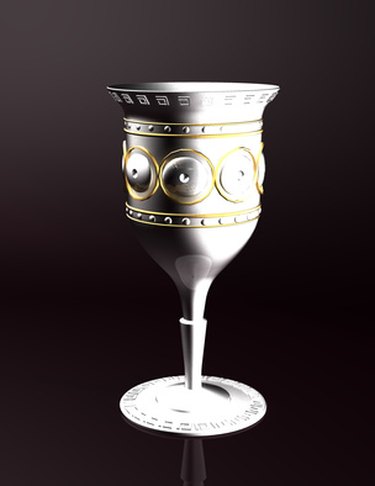
Silversmithing is the art of shaping and manipulating silver into useful objects such as drinking and eating utensils, jewelry, armour, vases and artistic items. Goldsmithing and silversmithing were synonymous to one another in ancient times. It was not until silver became more prominent and acceptable in society that the two occupations were separated.
Vocabulary
Video of the Day
The vocabulary of the modern day silversmith has been handed down through history and is said to date to 4695 B.C. Words used throughout history include: annealing, engraving, planishing, polishing, raising, repousse or repoussage, chasing, sinking and soldering. Annealing heats the metal for altering. Engraving cuts shallow designs into the metal. Planishing is using a highly polished hammering to refine the metal surface. Polishing uses abrasive compounds to make the surface smooth and shiny. Raising is the process of shaping a hallow form in the metal. Repousse or repoussage is imprinting a design from the back into the surface of the metal. Chasing is placing indentations into a repousse design from the front of object. Sinking is hammering the metal to create a concave hemispherical shape. Soldering is used to connect the metal with a low temp heat.
Video of the Day
Oldest Silver Artifact
The oldest known piece of tooled or silversmithed silver that has been discovered are The Silver Scrolls that date to 600 B.C. The Silver Scrolls consist of two small sheets of silver that were rolled into scrolls and found in a burial cave in Jerusalem. The text of the Priestly Benediction were found inscribed on the surface of the silver.
Tools and Technique
Many of the tools used in ancient times are still used by modern silversmiths. Ancient tools that have been modernized for the silversmith include tongs, hammer, anvil, engraving burins, small mallets, large scales, weights, ceramic furnace, blow pipe with clay nozzel.
Techniques used to join the silver together include welding, soldering and brazing. Documentation proves that soldering has been used since the 4th dynasty. Flux was used to hold the solder. The flux was made from either lees of wine or natron. The solder was either a soft or hard solder. The soft solder was made from tin. The hard solder was made from a combination of gold, silver and copper.
Separation of Trades
During the Middle Ages a separation between goldsmith and silversmith occurred. Silver was plentiful and cheaper than gold. Individuals starting out could not afford gold as their working medium. The goldsmith became more highly revered and was often the banker for the community. The silversmith took the training and skills of goldsmithing into a new trade market.
Studying or apprenticing for either profession is most generally done with the metal designated by the trade title. A silversmith will work with other metals such as copper, bronze, nickle-silver and brass. The goldsmith prefers only to work with gold.
Guilds
Guilds became popular during medieval times in Europe. The goldsmith organized the guild. A silversmith was allowed into the guild, but individuals working with brass or other metals were not. These individuals formed a separate guild for their trade.